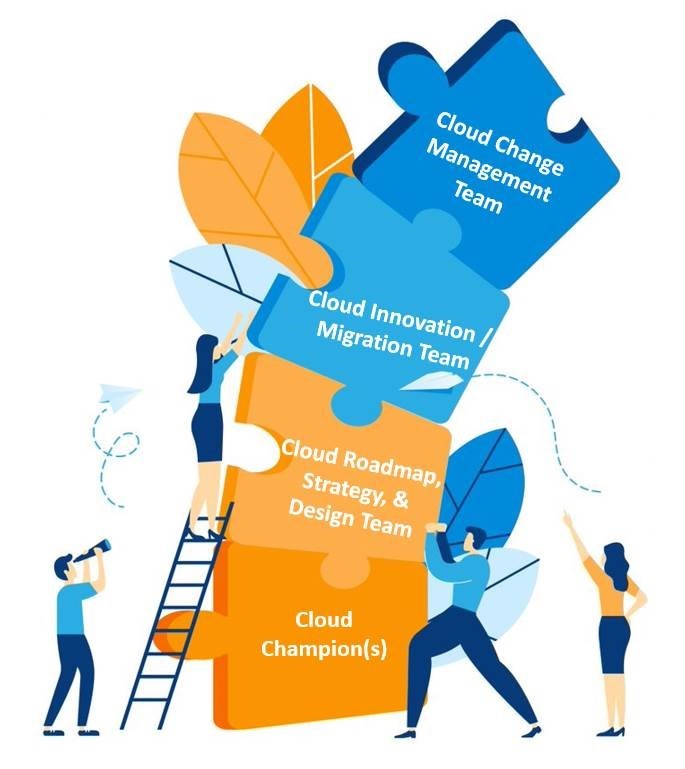When looking at statistics alone, the cloud has become an integral part of most organizations. Ninety-four percent of enterprises are already using a cloud service, and its anticipated public cloud infrastructure will grow by 35 percent in 2021.
Yet, cloud adoption is still a daunting prospect for many. An organization may have adopted some cloud services, but still operate largely from on-premises machines because it is familiar and may therefore feel safer. Also, many may not know why greater reliance on the cloud can benefit their business, or they may feel like the process to do so is inevitably not worth the effort.
In a previous blog post, we provided an overview of what the process of adopting cloud for your organization can look like, and we illustrated how understanding the “why” behind cloud adoption can set your organization up for success.
“Ultimately, justifying the cloud helps build the roadmap of metrics, milestones, and goals that are required for a successful adoption of the cloud.”
When thinking about the “why” of cloud adoption, it would be remiss not to mention some of the big cloud players. While there are several, in this blog, we will discuss two in particular – Amazon Web Services (AWS) and Microsoft Azure. By breaking down some of the core capabilities of each of these cloud computing services, the major benefits of increased cloud adoption will become apparent.5 Questions to Ask Before Moving to the Cloud Before diving into the benefits of cloud migration, it’s important to assess the current state of your organization’s infrastructure. When thinking about which cloud platform is right for your organization, there are some key considerations to flesh out as to what makes the most strategic sense.
1. Are you currently using more Azure services or more AWS services?
Familiarity and experience within a cloud platform is a significant asset when driving its adoption or expansion within your organization. If your organization is already relying on some Azure or AWS services, going with what you know may be a good option. For instance, you may be hosting workloads in Amazon EC2, meaning your team may already be familiar with the nuances and limitations of AWS. Your organization may even have existing processes for managing AWS workloads, such as existing start/stop and reservation cost management strategies.
By the same token, if your organization already consumes Microsoft cloud services within Microsoft 365 or Azure, your organization may benefit from existing licensing and services that cross product boundaries, such as Azure AD Premium licensing, or familiarity with Azure services and products your organization is already consuming.
2. Do you have existing licenses which may be portable to Azure, such as Windows Server, SQL Server, etc.?
A significant advantage Microsoft has in the cloud space is its ability to leverage existing investments in its wide portfolio of on-premises IT products. Its ability to offer a bring-your-own-license benefit for products such as Windows and SQL Server can drive significant savings when organizations already own licenses for these products with Software Assurance. While these savings are available on AWS in some situations, Microsoft holds a notable edge in this regard.
3. What main benefits can a move to the cloud offer your team?
And above all, the main question to answer: how does a move to the cloud truly benefit our organization? We will discuss some of the high-level answers to this question.
 Primary Cloud Migration Benefits
Primary Cloud Migration Benefits
Migrating to the cloud offers numerous benefits, but there are several “big picture” advantages that get to the heart of why cloud adoption can provide both immediate and long-term value to your organization.
Accelerate Business Outcomes
While on-premises equipment may feel familiar and functional, in many ways it can slow down considerably and constrain your organization’s efforts. By relying on on-premises servers, storage, and networking equipment you are tied to slow and costly procurement cycles and requirements. A move to the cloud means increased speeds. The cloud removes procurement bottlenecks and can allow you to go from weeks or months spent satisfying IT requirements for key business initiatives to as little as days or even hours. A move to the cloud offers less time waiting and more time innovating and actualizing business outcomes critical to moving your organization forward. Avoid Costly Upfront Capital InvestmentsCloud adoption also allows you to only use what you need. On-premises infrastructures require a large upfront investment that may cost thousands or even tens of thousands of dollars and requires extensive capacity planning to ensure resources are not significantly underutilized. With cloud, you can pay-as-you-go and easily scale up and down as needed, providing true flexibility for the evolving needs of your technology infrastructure. Your team can improve services and innovate without the constraint of limited existing compute capacity or costly expansion of an on-premises server footprint.
Both Azure and AWS offer similar consumption-based pricing and reservation options, with some slight differences.
Azure reservations allow organizations to pre-purchase a specific type of Azure resource for a long-term duration at a discount. Additionally, Azure also offers Azure Hybrid Benefit to reduce costs even further. With Azure Hybrid Benefit, you can use your on-premises Software Assurance-enabled SQL Server and Windows Server licenses, as well as RedHat and SUSE Linux subscriptions, on Azure. This can help you significantly lower your cost of ownership while taking advantage of cloud capabilities. There are also subscription-level offers. Examples include Azure Dev / Test, which can offer discounts for non-production workloads, and Cloud Solution Partner (CSP) programs. To that end, when you have an Azure subscription through Affirma’s CSP program, we offer a monthly discount on Azure spend, helping you to further reduce the costs of your cloud-hosted production workloads.
In addition to reservations, AWS offers Savings Plans which makes it easier to plan discounts across AWS EC2, AWS Fargate, and AWS Lambda. This allows you to commit to a minimum hourly spend, with a service-specific discount applied across all instances that are part of that spend commitment. This enables organizations to greatly simplify cost management while also realizing some savings relative to the pay-as-you-go model.
As both platforms employ a pay-as-you-go model, approaches which automatically start and stop instances that do not require 24/7 availability can also yield significant savings. Integration Capabilities Seamless integration with your current technologies and solutions is another advantage of cloud adoption. With proper planning, you can create a functioning hybrid or fully-cloud ecosystem of solutions.
Generally speaking, Azure integrates well with existing on-premises Microsoft ecosystems. While Azure integration is certainly not limited to Microsoft-only services and solutions, Microsoft provides tools and features to allow organizations to maximize value from their cloud investment. For example, Microsoft offers Azure AD Connect, which allows you to connect Azure AD with existing on-premises Active Directory deployments, Azure ATP, which can improve security posture on-premises, and SCCM co-management, which allows integration of SCCM and Intune. All of these can be used to enhance existing on-premises toolsets.
AWS offers similar opportunities for integration and enhancement of traditional on-premises capabilities. Services like AD Connector facilitate the extension of directory services to the cloud, and Security Hub can integrate numerous third-party tools to provide a cloud-based view of overall security in a single pane of glass. Streamlining Administration With PaaS One of the overarching benefits of the cloud is its ability to let you scale and stay agile. By leveraging platform-as-a-service (PaaS) offerings, regardless of whether using Azure or AWS, you can automate common IT tasks and simplify capacity planning as your database grows and evolves. This means your team can spend less time patching, backing up, and tuning resources and more time performing activities that drive value for the organization.
For example, both Azure and AWS offer PaaS relational database services. While there are differences between the two service offerings – for instance, with AWS offering Amazon RDS for Oracle, MariaDB, and Amazon Aurora – both can help reduce the overhead associated with traditional maintenance tasks. Azure SQL Database is automatically maintained at an “evergreen” (always patched) state, utilizing hot patching to push more than 80 percent of SQL patches to the database without a noticeable impact to end–users and automated failover to SQL replicas to minimize the impact of patches which do require a reboot. It also offers automatic, geo-redundant backups which support point-in-time restore for up to 7 days by default. By contrast, AWS Relational Database Service (RDS) automatically performs patches within a specified 30-minute window, which can be configured to leverage a multi-availability zone (AZ) deployment to minimize impact from required restarts. It also offers point-in-time restore of backups for up to 7 days by default. Cloud Support at Every StageSuccessful cloud migration is largely dependent on supporting processes. At Affirma, we take an iterative approach to cloud adoption and tailor our suggestions to the needs of our clients and the maturity of their cloud programs. At a high level, we assist clients in four stages of their cloud journey into Azure and AWS:
- Cloud Foundations: Initial cloud adoption and deployment of foundational services, including baseline network, storage, compute, directory services, security, identity and access management (IAM), and cost management strategies. Also, if necessary, the establishment of a hybrid cloud model, which allows the interconnection between on-premises and either AWS or Azure systems.
- Cloud Maturity: Development of existing cloud environments, which includes optimization of cloud costs, reporting, monitoring, security enhancement, and specialized needs.
- Cloud Refactoring: Adjustment of existing Azure and AWS environments to reduce the manual effort associated with traditional server maintenance, such as patch management and backup, so your IT team can focus on value-add activities instead of routine maintenance. Assistance in transition from IaaS to PaaS models where appropriate.
- Specialty Needs: Planning and deployment of environments with highly specialized environments, such as high compliance zones (e.g., PCI, NIST, HIPAA, etc.) in Azure and AWS.
 Cornerstones of Cloud Migration
Cornerstones of Cloud Migration
While technology is an essential component of cloud migration, the people and processes that support the migration and ongoing maintenance of the environment are also critical considerations. We believe there are three core components to successful cloud migration.
People: Focusing on the people who will be using and supporting your cloud infrastructure is critical. Team skills and structure are deciding factors in successful cloud adoption. Identifying cloud champions and developing an effective communication strategy can help promote enthusiasm and support for a cloud program which can ultimately drive growth.
Process: Our approach to the cloud migration process includes consideration of current migration projects, security and governance, the culture of the organization, and more. For example, some organizations may operate well in agile processes, while others may be more accustomed to an approach that emphasizes ITIL. Tailoring processes to the culture of the organization can help your organization mature processes to maintain, develop, and support cloud infrastructure in a way that works for your organization. Technology: Technology is crucial. Backup and recovery, network architecture, configuration and deployment standards, identity and access management, cost management, and site-to-site connectivity are all aspects of the technology stack that should not be overlooked. Understanding your long-term roadmap and building your environment in a way that will accommodate your mid-and long-term goals will pay dividends in future stages of your cloud adoption. While there are many factors to consider when moving to the cloud, successful and thoughtful adoption of the cloud is a long-term investment that will allow your technology to scale and grow as your organization does. With careful upfront planning, the cloud can enable you to automate routine tasks, simplify cumbersome procurement processes, accelerate the realization of business outcomes for IT investments, and potentially even reduce overall IT spend, ultimately providing significant value to the success and growth of your organization.




